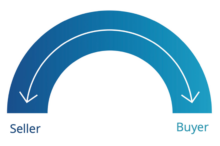Brand-building for Competitive Advantage
A strong brand is especially important for small businesses, which are unlikely to have the spending power or marketing resources available to larger competitors. The smaller business can play to the strengths of its brand relationship with its customers to distinguish it from other businesses in the marketplace, and so level the playing field.
This article first appeared in Accountancy Ireland in April 2023
Clever branding can mean the difference between success and failure for small businesses competing in a crowded market, writes Gerard Tannam
A strong brand is good for business. It gives a business an advantage over its competitors by distinguishing it from them in a way that matters to customers and influences their choices.
Despite its importance, however, this simple business tool, which is available to every business, is often misunderstood, underestimated, and underused, particularly by smaller businesses.
‘Brand’ can be defined in many ways: as a mark of origin or quality, as image or reputation, as a proposition or promise, and even as a badge of community or a shared belief system. But none of these is entirely satisfactory. While each definition says something true about what a brand is or can be, none capture the part a brand plays in choice.
A definition of brand
As well as being a tool that businesses use to influence choice, brand is also the tool that customers use to make their choices and reassure themselves that they are correct. When customers are spoilt for choice or do not have the time or inclination to analyse every buying decision, they often rely on brand to help them choose.
And so, the brand tool is used in two different though complementary ways:
• a business uses brand to help it become the natural choice of its customers;
• its customers use brand to help them make the right choice of product or service.
A brand is a tool that influences choice by reflecting the relationship between buyer and seller and the value they exchange.
Marks of quality or identity, such as names, symbols or logos, are means of representing the brand relationship and its value, rather than being the brand. Wedding rings, for example, symbolise a relationship (marriage) between two people – they are not the relationship itself.
The Brand Bridge
To understand brand and how it works, consider the relationship between buyer and seller as a ‘bridge’. Just as a bridge is designed to enable people to cross over safely, quickly, and easily from one side to the other, a brand bridge enables people to exchange value safely, quickly, and easily.

The two-way traffic on the bridge of give-and-take between buyer and seller suggests a partnership of equals, both of whom want something the other has and must agree on the value to be exchanged through the transaction. Brand bridges are more handshake than arm wrestle, a basis for good and sustainable business.
A definition of branding
Defining brand as a tool for business leads to a definition of ‘branding’ as the influencing of choice by building a relationship between buyer and seller based on the value they exchange.
A brand relationship establishes a connection between a business and its customers around the value each understands the other is offering. Branding involves putting the brand relationship to work to build and maintain the commercial relationship with existing customers and turn potential buyers into new customers.
Why branding matters to small businesses
Success in business comes down to an ability to influence choice. A superior product or service only takes a business so far. Many hardworking businesses have brought an exceptional offering to market and failed. To be successful, a business must influence enough of the right kind of customer to choose what it brings to market.
Brand relationship plays a critical role in the choices customers make. Even in a busy marketplace, where customers are spoilt for choice, a strongly branded business can lead its market and command a premium for its product or service.
Every business has a brand, strong or weak. The brand’s strength or weakness results from actions taken by the business in building the relationship with its customers.
A strong brand is especially important for small businesses, which are unlikely to have the spending power or marketing resources available to larger competitors. The smaller business can play to the strengths of its brand relationship with its customers to distinguish it from other businesses in the marketplace, and so level the playing field.
Five steps to defining a brand
1. Define the value to be exchanged
The value to be realised through the brand relationship is not set by one side or the other but must be agreed. For any relationship to work both parties must continue to see and realise its value. However, while the brand relationship is defined by the value sought by the buyer and offered by the seller, this must at least match the seller’s asking price for the exchange to work.
The asking price, which the business requires for the exchange to be profitable, is a useful starting point for defining value. This is typically based on the costs of the resources the business must invest in the relationship, plus its margin or premium. Then the business considers how the customer is likely to rate the benefits on offer, if this accumulated value matches or tops the asking price, and whether they are likely to pay it.
2. Identify and target the ‘best customer’
For the brand relationship to work, it is vital that the business carefully chooses the type of customer with whom it and its value proposition are best matched.
When business development lacks focus, a business will attract a wide variety of prospective customers, some well matched with it, but many not. A business that deals with too broad a mix of customers will struggle to profitably realise the value in many of its individual transactions. A well-matched or ‘best customer’, on the other hand, will add predictable and significant value to the exchange and deliver the premium that the business needs.
Your best customer:
• needs what you have to offer, considers it essential,
• wants what you are offering, finds it highly desirable;
• values what it, prioritises it above all others;
• engages fully with all of the elements of your offering, not just its purchase;
• can pay for it (an ability not confined to affordability).
3. Identify and fix the customer’s ‘key problem’
People buy from other people to fix what they experience as a problem and to enjoy the benefits that result. Potential customers are more likely to be ‘best customers’ when they consider that the product or service offered by a business fixes their key problem.
There are two aspects or sides to a customers’ key problem: the practical and the social. The practical is what the product or service does and the direct, functional benefits it provides, while the social is how the customer relates to others and the world through their choice of that product or service and can be understood in terms of how it makes them feel.
For example, someone is thirsty and buys bottled water. Any bottled water will do. Another customer is thirsty but is concerned that many bottled water products use irreplaceable natural resources. They choose a brand of water that is carbon-neutral with recycled packaging. The business with the sustainable brand has found its best customer; the customer has used brand value to meet all their needs and fix their problem.
4. Identify and fix both aspects of the key problem
More customers are choosing products and services that fix the practical and social aspects of their problems, so it is important that a business identifies both aspects and determines the role that it will play in fixing them.
This role must go deeper than the complementary role of seller to the customer’s buyer, and deeper too than the functional role played by the business in fixing the practical problem.
When the product or service offered by a business is largely the same as that offered by its competitors, it is the role that the business plays in resolving the social aspect of its customer’s key problem that adds real value, and greater profitability, to the transaction.
For example, a business owner seeks an accountant to prepare monthly accounts to support management of the business. Any suitably qualified accountant can answer this practical aspect of the business owner’s problem. However, the owner struggles to make sense of how accounts relate to their business and can feel overwhelmed and helpless. They will choose an accountant that fixes this personal (social) part of the problem, guiding and advising the owner to help them to understand the numbers and the performance of their business.
5. Provide information required for the buying decision
When customers are considering which product or service to choose, they will search for some or all of 10 types of information about how a business solves their key problem:
• Attraction – ‘What is it about this offer that appeals to me?’
• Engagement – ‘What tells me that this offer is right for me?’
• Demonstration – ‘How does this offer work?’
• Sample – ‘How can I try this offer for myself?’
• Testimonial – ‘Who else has benefitted from this offer?’
• Proposition – ‘How do I take up this offer?’
• Delivery – ‘How is this offer provided to me?’
• Support – ‘How will you help me make the most of this offer?’
• Recovery – ‘What will you do to help me if something goes wrong?’
• Feedback – ‘How will I let you know what I think of your offer?’
Final Word
When the success of a business depends on the effectiveness of its brand in influencing choice, building brand relationships should not be left to chance. Branding is a tool available to every business. Every type of business can compete for their best customers with a strong brand that influences choice. Because a smaller business can play to the singular strengths of its brand relationships with customers to distinguish it from others, it can level the playing field with its own competitive advantage.


